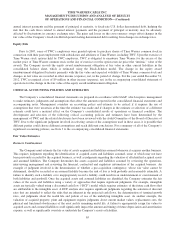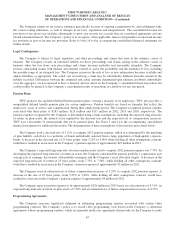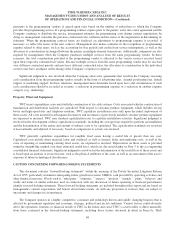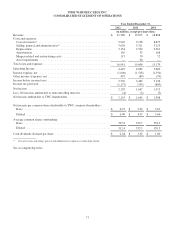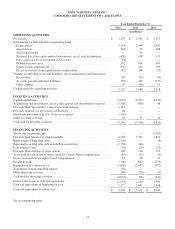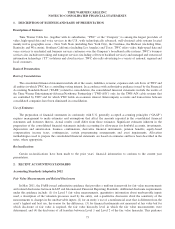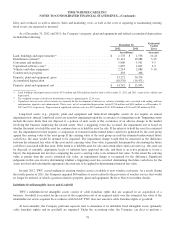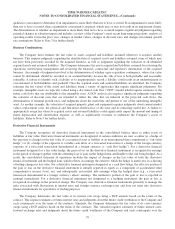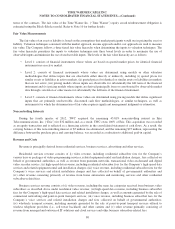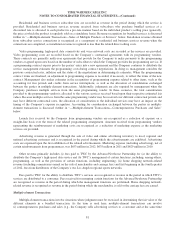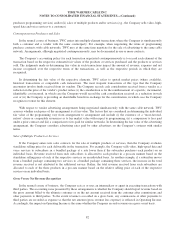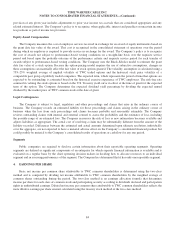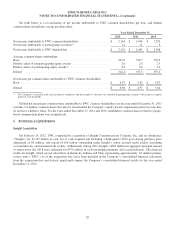Time Warner Cable 2012 Annual Report Download - page 85
Download and view the complete annual report
Please find page 85 of the 2012 Time Warner Cable annual report below. You can navigate through the pages in the report by either clicking on the pages listed below, or by using the keyword search tool below to find specific information within the annual report.TIME WARNER CABLE INC.
NOTES TO CONSOLIDATED FINANCIAL STATEMENTS
1. DESCRIPTION OF BUSINESS AND BASIS OF PRESENTATION
Description of Business
Time Warner Cable Inc. (together with its subsidiaries, “TWC” or the “Company”) is among the largest providers of
video, high-speed data and voice services in the U.S., with technologically advanced, well-clustered cable systems located
mainly in five geographic areas – New York State (including New York City), the Carolinas, the Midwest (including Ohio,
Kentucky and Wisconsin), Southern California (including Los Angeles) and Texas. TWC offers video, high-speed data and
voice services to residential and business services customers over the Company’s broadband cable systems. TWC’s business
services also include networking and transport services (including cell tower backhaul services) and managed and outsourced
information technology (“IT”) solutions and cloud services. TWC also sells advertising to a variety of national, regional and
local customers.
Basis of Presentation
Basis of Consolidation
The consolidated financial statements include all of the assets, liabilities, revenue, expenses and cash flows of TWC and
all entities in which TWC has a controlling voting interest. In accordance with authoritative guidance issued by the Financial
Accounting Standards Board (“FASB”) related to consolidation, the consolidated financial statements include the results of
the Time Warner Entertainment-Advance/Newhouse Partnership (“TWE-A/N”) only for the TWE-A/N cable systems that
are controlled by TWC and for which TWC holds an economic interest. Intercompany accounts and transactions between
consolidated companies have been eliminated in consolidation.
Use of Estimates
The preparation of financial statements in conformity with U.S. generally accepted accounting principles (“GAAP”)
requires management to make estimates and assumptions that affect the amounts reported in the consolidated financial
statements and footnotes thereto. Actual results could differ from those estimates. Significant estimates inherent in the
preparation of the consolidated financial statements include accounting for allowances for doubtful accounts, investments,
depreciation and amortization, business combinations, derivative financial instruments, pension benefits, equity-based
compensation, income taxes, contingencies, certain programming arrangements and asset impairments. Allocation
methodologies used to prepare the consolidated financial statements are based on estimates and have been described in the
notes, where appropriate.
Reclassifications
Certain reclassifications have been made to the prior years’ financial information to conform to the current year
presentation.
2. RECENT ACCOUNTING STANDARDS
Accounting Standards Adopted in 2012
Fair Value Measurements and Related Disclosures
In May 2011, the FASB issued authoritative guidance that provides a uniform framework for fair value measurements
and related disclosures between GAAP and International Financial Reporting Standards. Additional disclosure requirements
under this guidance include: (1) for Level 3 fair value measurements, quantitative information about unobservable inputs
used, a description of the valuation processes used by the entity, and a qualitative discussion about the sensitivity of the
measurements to changes in the unobservable inputs; (2) for an entity’s use of a nonfinancial asset that is different from the
asset’s highest and best use, the reason for the difference; (3) for financial instruments not measured at fair value but for
which disclosure of fair value is required, the fair value hierarchy level in which the fair value measurements were
determined; and (4) the disclosure of all transfers between Level 1 and Level 2 of the fair value hierarchy. This guidance
75


